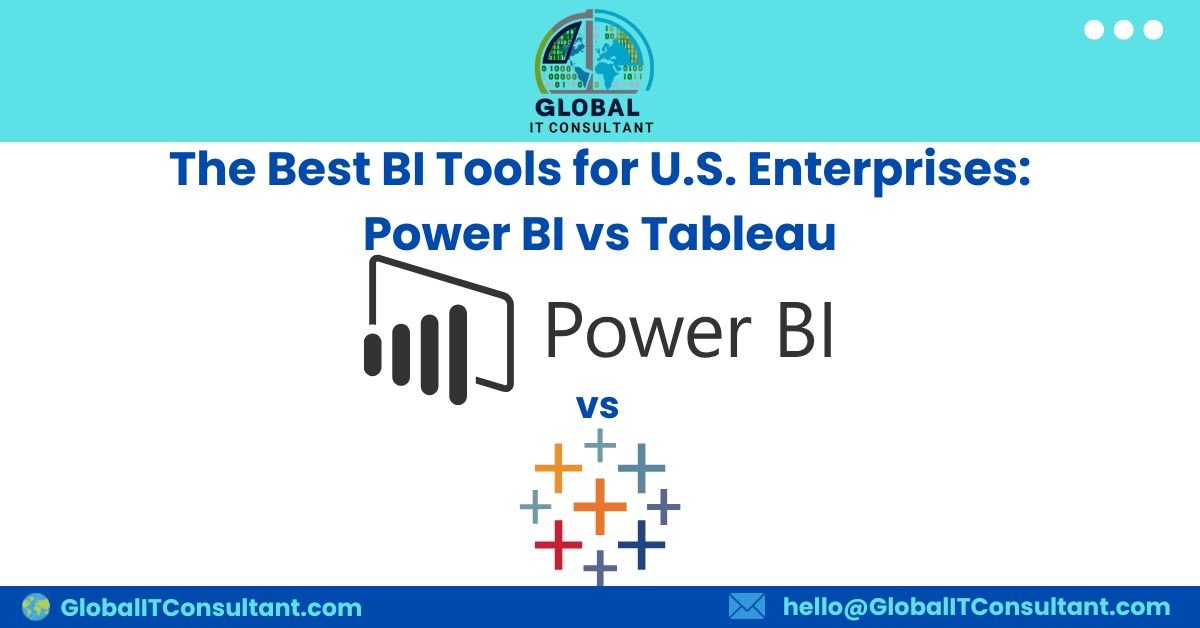By Global IT Consultant
In a data-driven world, Business Intelligence (BI) tools are no longer optional for U.S. enterprises—they’re mission-critical. From real-time dashboards to predictive analytics, BI platforms help organizations uncover insights, monitor KPIs, and make smarter decisions.
Among dozens of solutions, Power BI (by Microsoft) and Tableau (by Salesforce) consistently top the list for American enterprises. Both have loyal followings and robust feature sets—but which tool is the better fit for your business?
At Global IT Consultant, we’ve helped Fortune 500 companies, mid-market firms, and fast-growing startups evaluate, deploy, and integrate both platforms. Here’s an in-depth look at how Power BI and Tableau compare, and what U.S. enterprises should consider before choosing.
Why BI Tools Matter More Than Ever
- The average enterprise manages terabytes of structured and unstructured data
- Fast-changing U.S. markets require real-time visibility to respond quickly
- Compliance and risk teams rely on dashboards to track metrics and meet regulatory demands
- Executives need visual, shareable reports to align teams across departments
Choosing the right BI tool can directly impact speed, clarity, and business growth.
Power BI: Strengths & Ideal Use Cases
Power BI is tightly integrated with Microsoft 365, Azure, and other Microsoft products. Key strengths include:
✅ Affordability: Power BI Pro starts at about $10/user/month—appealing for large enterprises wanting to license thousands of users.
✅ Familiar interface: Built on Excel DNA, making adoption easier for teams already comfortable with Microsoft tools.
✅ Deep Microsoft integration: Seamless connections to Azure Synapse, Dynamics 365, SQL Server, and more.
✅ Self-service and governance: Allows power users to build custom dashboards, while IT can control data sources and permissions.
✅ AI & machine learning: Features like natural language Q&A and predictive analytics.
We have created 200+ dashboards on Power BI. HR Analytics, Sales Analytics, eCommerce Analytics etc. are our expertise.
Ideal for:
- Enterprises heavily invested in the Microsoft ecosystem
- Organizations wanting fast deployment and lower TCO (total cost of ownership)
- Teams with mixed technical skill levels—from analysts to business users
Tableau: Strengths & Ideal Use Cases
Tableau is renowned for its advanced data visualization and interactive exploration. Key strengths include:
✅ Best-in-class visualization: More customization, flexibility, and design options than most BI tools.
✅ Powerful data blending: Easily combine multiple data sources, structured or unstructured.
✅ User-driven exploration: Allows analysts to dive deeper without relying on IT.
✅ Large data handling: Optimized to handle complex, high-volume datasets.
✅ Community and support: Strong U.S. user community, forums, and partner network.
Ideal for:
- Data-driven enterprises prioritizing complex visual storytelling
- Companies with dedicated data teams or analysts
- Organizations using multiple non-Microsoft data sources
🔍 Power BI vs Tableau: Feature Comparison
| Feature | Power BI | Tableau |
|---|---|---|
| Price | Lower entry cost | Higher, often starts ~$70/user/month |
| Ease of use | Easier for Excel users | Steeper learning curve, but more flexible |
| Visual capabilities | Robust, slightly less customizable | Industry-leading, highly customizable |
| Data integration | Best with Microsoft & Azure stack | Wide variety, especially non-Microsoft data |
| Deployment options | Cloud-first; on-premises via Power BI Report Server | Cloud, on-premises, or hybrid |
| AI & natural language | Built-in; strong AI integrations | Improving, but less native AI |
Cost & Licensing Considerations for U.S. Enterprises
- Power BI’s per-user pricing model often makes it cost-effective for large organizations adding thousands of seats.
- Tableau uses Creator, Explorer, and Viewer licenses, allowing more granular access but potentially higher overall cost.
- U.S. enterprises should also account for indirect costs: training, data modeling, support, and governance.
Integration & Customization
Power BI:
- Native connectors to Microsoft products
- API for custom visuals
- Power Automate integration for workflows
Tableau:
- Rich REST API and SDK for embedding dashboards in portals or apps
- Strong support for data prep tools like Tableau Prep
Integration strategy should align with your enterprise’s existing architecture.
Real-World Example: U.S. Retail Chain
A national retailer partnered with Global IT Consultant to modernize analytics:
- Used Power BI for operational reporting tied to ERP and Microsoft Dynamics.
- Deployed Tableau to analyze customer data from web, social, and third-party sources—delivering advanced marketing insights.
Result: a hybrid BI strategy combining cost-effective enterprise reporting with deeper customer analytics.
Which BI Tool Should Your Enterprise Choose?
Ask these questions:
- Are we deeply invested in Microsoft technologies? → Power BI
- Do we need advanced, complex visual storytelling? → Tableau
- What’s our data source landscape? Mostly Microsoft or diverse?
- What’s the skill level of our users? Business users vs. data scientists
- Do we prefer lower cost per user, or richer visual features?
Final Thoughts
Both Power BI and Tableau are excellent, enterprise-grade BI tools trusted by U.S. businesses. The right choice depends on your data environment, goals, user base, and budget.
At Global IT Consultant, we help enterprises evaluate, deploy, and optimize BI platforms—so data drives your strategy, not your headaches.
👉 Ready to explore Power BI, Tableau, or a hybrid approach?
Let’s build your data roadmap.
Contact us for Data Analytics Consulting

